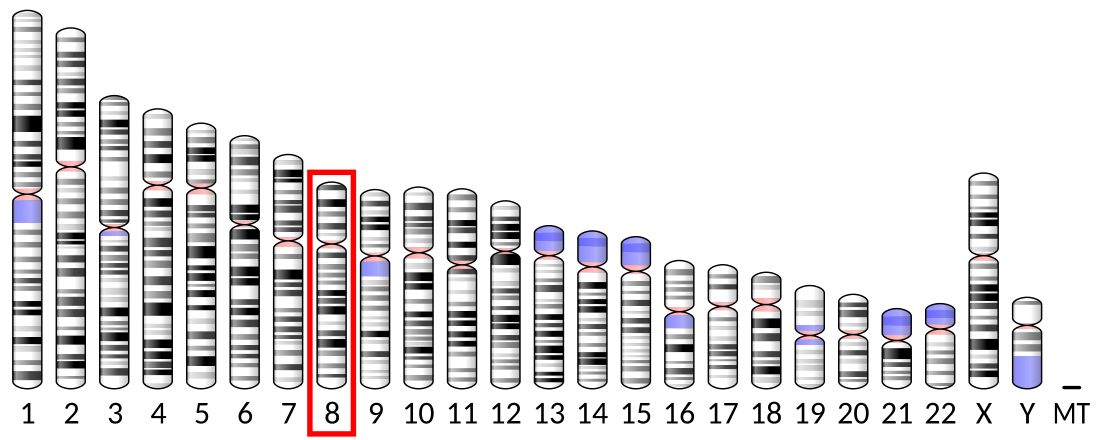Top Qs
Timeline
Chat
Perspective
ZNF703
Protein-coding gene in the species Homo sapiens From Wikipedia, the free encyclopedia
Remove ads
ZNF703 is a gene which has been linked with the development of breast cancers.[5][6][7] ZNF703 is contained within the NET/N1z family responsible for regulation of transcription essential for developmental growth especially in the hindbrain.[8] Normal functions performed by ZNF703 include adhesion, movement and proliferation of cells.[8] ZNF703 directly accumulates histone deacetylases at gene promoter regions but does not bind to functional DNA.[9]
Following research by scientists at Cancer Research UK, it was the first oncogene discovery in the past six years.[6]
ZNF703 is a part of 8p12 telomeric amplicon that is associated with Luminal B breast cancer. Recently, ZNF703 is identified as the driver of 8p12 locus amplification.[10]
Patients diagnosed with luminal B cancer caused by ZNF703 typically have lower recovery and survival rates than other cancer types.[11]
Drug resistance of ZNF703 has been displayed when patients are treated using anti-cancer drug Tamoxifen.[12]
Remove ads
Discovery
Researchers discovered the carcinogenic nature of ZNF703 in 2011 while conducting research on the classification and resistance of various oncogenes.[8] Researchers attempted to discern factors associated with various cancer types through observation of the oncogenic mechanism on a molecular scale.[8] The luminal B cancer pathway exhibited an amplification of 5 different genomic areas including the chromosome region 8p12.[8] Amplification of region 8p12 occurred through transcriptional regulation of ZNF703.[8]
Remove ads
Location

ZNF703 is located on human chromosome 8 at the short arm region commonly named chromosome region 8p12.[5] Tumors generated by ZNF703 have shown loss in size beginning at the telomere and ending at 8p12 while the 8p12-11 region has increased size.[13] A fluctuation between increase and decrease is present along the 8p12-8p21 boundary region of the chromosome.[13] A pattern has been found that involves three similar regions of disrupted growth and four regions of enhanced growth starting from the telomere and ending at the centromere.[13]
Remove ads
Role in cancer
The ZNF703 gene generally plays an active role in luminal B tumor cells contained in mammary ducts.[5] Typically, ZNF703 expression is greater when the tumors are estrogen receptor positive as opposed to estrogen receptor negative.[5] ZNF703 is co-expressed in a nuclear complex containing genes DCAF7, NCRO2 and PHB2.[5] ZNF703 generates a nuclear protein responsible for oestrogen receptor associated protein repression.[5] Gene expression of stem cells are triggered when the ZNF703 gene becomes overexpressed in the complex.[5] As a result, both regular cells and cancer stem cell abundance increases rapidly.[5] ZNF703 overexpression also causes primary and secondary tumorsphere development alongside amplified production of CD49F- positive cells associated with colon cancer.[5]
ZNF703 also experiences target regulation of cancer cells through the transcription of RNA SPRY4-It1.[14] RNA SPRY4-IT1 is a non-coding gene responsible for preventing apoptosis and generating large tumors.[14]
Researchers recently established a link between the trigger gene ZNF703 and Akt/mTOR pathway activation involved in the cellular cycle resulting in lung tumor formation.[15]
Prognosis
The lifespan of individuals with colorectal cancer and luminal cancer have different prognosis depending on the amount of expression of the ZNF703 gene.[11] Low amounts of transcription of ZNF703 usually leads to a healthier prognosis than individuals experiencing higher levels of transcription of the oncogene.[11] ZNF703 is a target for therapeutic medicines since survival rates increase as transcription rates decrease.[11]
Remove ads
Resistance to drugs
The drug Tamoxifen is a commonly administered drug used to treat luminal cancers in patients.[12] Half of patients treated with Tamoxifen are resistant to the drug.[12] Overexpression of ZNF703 has been linked to Tamoxifen resistance.[12] As transcription of the ZNF703 gene reaches substantial levels, instead of blocking cell proliferation, Tamoxifen is found to increase cancer cell division.[12] Tamoxifen can only be given at low dosages and patients are monitored daily in order to avoid tumor growth.[12]
Remove ads
References
Wikiwand - on
Seamless Wikipedia browsing. On steroids.
Remove ads




